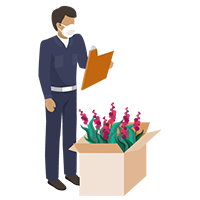We have been improving this page and would like to hear from you.
Share your feedback at the end of the page. Answer the question ‘Was this page helpful?’. You can also add comments to your response.
News and alerts
We’ve strengthened import requirements for live plants (nursery stock) to protect against the bacterial plant pathogen Xylella. Find out how Xylella measures will affect you.
Read other important announcements that may affect how you import plant and plant products.
Subscribe to receive import industry advice notices.
Nursery stock includes live plants and plant material other than seeds imported for growing or propagating.
All imported nursery stock— except orchid tissue cultures brought through the airport as accompanied baggage – requires an import permit. This is regardless of the amount or whether it’s for personal or commercial use.
We inspect all nursery stock imports on arrival in Australia.
Some nursery stock will also require treatment, post entry quarantine growth and testing for pests and diseases.
Before you import
You must comply with the import conditions for nursery stock.
Import conditions help to prevent the entry of exotic pests, diseases and other biosecurity risk material into Australia.
Import conditions can vary depending on the:
- genus and species
- form of plant material
- country of origin of plant material.
Importing nursery stock can be a complex process. Use this guide and read the information carefully before you apply to import any amount of nursery stock, for commercial or personal use.
Imported plants must:
- only contain permitted plant species
- be free from live pests, soil, disease symptoms, contaminant seed, other plant material (contaminating leaf, stem material, fruit pulp, pod material, etc.), animal material (animal faeces, feathers, etc.) and any other material of biosecurity concern
- be packed in clean, new, pest-proof packaging and clearly labelled with the full botanical name of the plant (genus and species).
Before you import your plants, you will need to:
- know the scientific name of the plant, often referred to as the botanical name (genus and species)
- know the form of plant material you are importing
- arrange on-arrival treatment and post-entry quarantine if required. Do this before applying for an import permit
- apply for an import permit
- work with your supplier to have the goods inspected pre-export and prepared for shipment
- gather all required documents
- submit a notice of importation
- know about any fees and charges.
Use the scientific name to check BICON for the full list of conditions you need to meet for your import. Once you have found the right BICON case, you will be asked some questions and then directed to the relevant import scenario and import conditions.
For a demonstration on how to use scientific name search in BICON, watch the following video.
BICON Scientific Name Search Demonstration
You can search BICON using the following three options. “Quick search”, Scientific name” and “Tariff code”.
Using scientific names is the most effective way to find seed and nursery stock cases.
To do this, select the “Scientific name” tab.
You can search by genus or at species level.
Enter the scientific name you wish to search for in the search box. In this example we are using “Cucumis sativus” as our search term.
Then click the “Filter” button to display a list of available scientific names.
Select your preferred result and click the “Search” button.
You will be presented with several results. You will need to read the case descriptions and choose the most appropriate case.
In this example, we will select the “Cucumis sativus seed for sowing” case.
Once you are in the case, answer the questions to determine which biosecurity conditions you must comply with.
Ensure you read the conditions carefully. You can email or call us on 1800 900 090 if you have any questions.
A courier service or customs broker can also help you meet all conditions. They can also help you with lodging import documentation and other border clearance requirements.
Goods that don’t meet the import conditions will not be permitted entry into Australia.
Approved sources of tissue cultures free of media
We accept imported tissue cultures free of media from certain overseas facilities. See our list of approved offshore suppliers.
Other agencies
You may also need to meet laws and requirements set by other Australian commonwealth and state/territory authorities.
Make sure you’re aware of all your obligations. Check with other agencies before you bring goods into Australia.
You can use a customs broker to help you with this.
If the species is not permitted
You can’t import a plant species that is not permitted until import conditions have been developed and published on BICON.
To import a species not listed in BICON we need to undertake a weed risk assessment first. A disease risk assessment may also be required.
You can send us a completed new plant introduction form to have it considered.
The assessments may take more than a year to complete. There is no guarantee your application will be successful.
Some live plants will require on-arrival treatment and post-entry quarantine (PEQ) growth.
Use BICON to check any treatment or PEQ requirements, including whether the plants will need to:
- go into the government PEQ facility, or
- undergo PEQ at a third-party approved arrangement (AA) site.
To make a booking at the government PEQ facility use our Post Entry Biosecurity System (PEBS).
To book the plants into an AA, contact the AA site operator.
Make these arrangements before you apply for an import permit.
Before you apply
Live plants can only be imported to Australia under an import permit we have issued. The only exception where a permit is not required is for imported orchid tissue cultures brought through the airport as accompanied baggage.
Make sure you:
- read the information on how to apply for an import permit in BICON
- register for a BICON account if you don’t already have one
- know the scientific name and form of the imported plant material
- obtain a valid import permit well in advance of the arrival of your goods in Australia.
Apply for a permit
To apply:
Login to BICON.
Select the ‘apply now’ button.
When we receive your application, we will:
- check you have supplied all information
- assess the application
- review and assess any previous import compliance
- request any further details we need for our assessment
- advise you of the outcome.
Your application must include sufficient evidence that you can comply with the import conditions to be granted an import permit.
You can email or call us on 1800 900 090 if you have any questions.
Import permit fees and charges are non-refundable.
Pre-export inspection
Your supplier must arrange for the exporting country’s National Plant Protection Organisation (NPPO) to inspect the live plants before shipment to Australia.
Make sure your supplier knows Australia’s import conditions.
If the NPPO is satisfied that the plants meet Australia’s import conditions, they will issue a phytosanitary certificate.
Preparing your goods for shipment
Work with your supplier to prepare your plants for shipment.
Following are tips to keep your plants healthy during transportation and complete our on-arrival biosecurity requirements without delay:
- don’t send plants with soft, tender new growth
- choose plants that have hardened off
- send dormant material if the plant is deciduous or a perennial such as bulbs, corms, tubers
- avoid any constricting ties that may bruise the plants
- minimise the shipping time for perishable plants. Airfreight is usually the fastest. Sending by international mail is not recommended.
- remove surplus foliage and flowers to reduce condensation and dehydration in transit
- use temperature controlled shipping to maintain good plant health
- package any tissue culture vials or containers in a way that prevents breakage.
- You may also use certain packing material that protects the plant from damage during transport. For information on acceptable packaging materials, search for “packing materials and packaging of plants” in BICON.
If you’re mailing or ordering goods online, make sure you:
- use a reputable supplier
- clearly mark on the parcel “Attention Biosecurity - Live plant material”
- address the parcel as per the instructions in BICON. This will generally be either directly to the government PEQ facility or care of a regional nursery stock team
- include your import documents such as import permit, packing list, invoice, phytosanitary certificate in an envelope. Secure the envelope inside and to the outside of the parcel.
- Check all requirements for sending and ordering goods online from outside Australia.
Live plants pose a high biosecurity risk. If you’ve received plants by mail that you didn’t order report it to our See. Secure. Report. hotline on 1800 798 636
Phytosanitary certificate
A phytosanitary certificate is issued by the exporting government National Plant Protection Organisation. It states that the plants or plant products have been inspected and are free from live pests of biosecurity concern.
Check BICON for any specific phytosanitary certificate requirements.
Import permit
All imported live plants must be accompanied by a valid import permit. The only exception where a permit is not required is for imported orchid tissue cultures brought through the airport as accompanied baggage.
A customs broker can lodge the documents to us on your behalf.
You must complete a notice of importation form (NOI).
Email the completed NOI to the relevant regional office before the plants arrive in Australia.
The NOI notifies us of your expected consignment. To minimise any delays to your goods being inspected on arrival, we must receive the NOI:
- for full container load consignments, before the container is shipped.
- for all other consignments, at least 7 working days before consignment’s arrival.
On arrival
A biosecurity officer will review your documents to ensure the plants meet Australia’s import conditions.
Documents we will ask you to provide include:
- phytosanitary certificate
- import permit
- supplier’s invoice and transport information
- incoming passenger card (for goods carried as accompanied baggage).
If the documentation we receive is invalid or incomplete, we will not be able to clear the goods.
A biosecurity officer will:
- check the packaging for cleanliness and damage and secure the consignment if necessary.
- inspect for live pests, weed seeds, diseases and other biosecurity risk material.
If no biosecurity concerns are found and all import conditions have been met and the goods do not require onshore treatment, post-entry quarantine growth or testing, they are released from biosecurity control.
If any biosecurity concerns are found, the biosecurity officer will share the results and provide you or your customs broker with management options. These may include:
- destroying the goods
- exporting the goods out of Australia
- treating the goods so they are safe to enter Australia.
This may be applied to the whole shipment, or just the contaminated part.
These actions are undertaken at the importer’s expense.
Learn more about how we inspect and clear imported goods.
Most imported non-tissue cultured plants must be treated on arrival in Australia. Check your import permit for any required treatments for your goods.
Please be aware that some treatments may affect the health of your plants.
As a final step, your plants may need to be grown and tested in a government post-entry quarantine (PEQ) facility or at a third-party approved arrangement site before we release them to you.
Growing the plants helps us ensure they are free of exotic pests and diseases that may cause harm if introduced into Australia.
The required growing period varies. Some plants can be grown and released within a few months, while others may need to be grown for a couple of years. Some plants will also need to be tested for certain pests or diseases.
Check your import permit for any PEQ and testing requirements.
Fees and charges
You are required to cover all associated import costs.
For information about costs relating to:
- import permits, inspections, testing and PEQ at the government facility, check our charging guidelines
- PEQ in a third-party facility, contact the approved arrangement site operator
- fumigation, contact your fumigation provider
- phytosanitary certification, contact your supplier or the exporting country National Plant Protection Organisation.
How we manage pests
Learn how we work with you, domestic growers and the community to protect Australia from pests in imported plants.
Check out our bite-sized biosecurity videos. Each explores ways we work at the border to prevent the arrival of exotic plant pests.
Stay informed
Make sure you’re aware of all your responsibilities for importing goods to Australia.
Need help?
Email the Imports team or call 1800 900 090.





